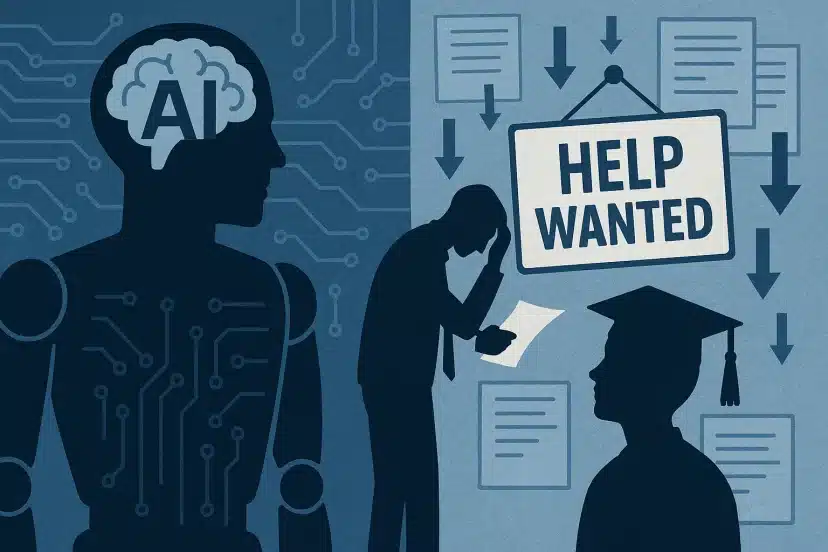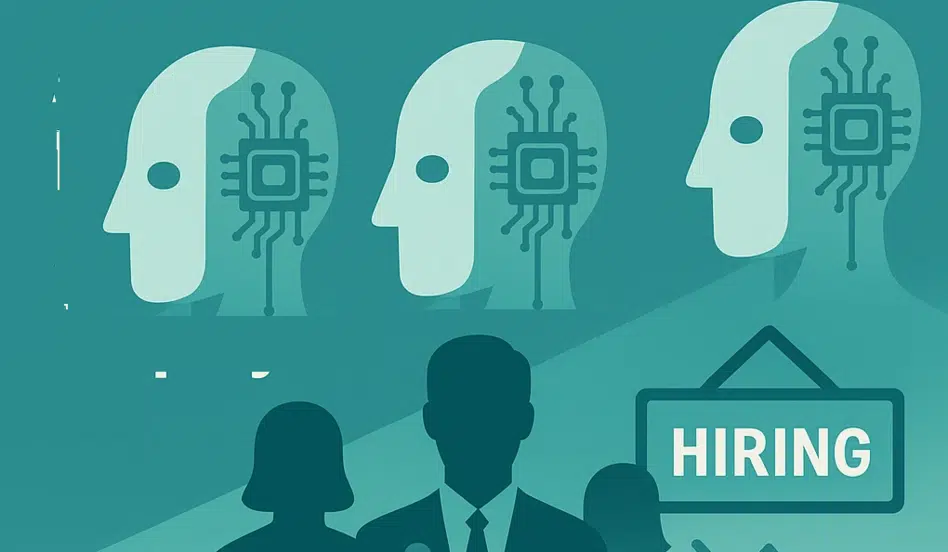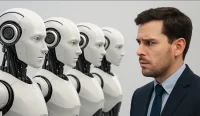AI impact on hiring in 2025 is shaping employer decisions more than ever before. Artificial intelligence has shifted from a futuristic concept to a daily corporate reality. Generative AI platforms, machine learning algorithms, and advanced automation tools are now embedded across industries from tech and banking to marketing and logistics.
While businesses are embracing AI for its cost-saving and productivity-boosting benefits, a new trend is emerging: employers are slowing down recruitment, not because they lack work, but because they fear AI will soon make those jobs redundant. This demonstrates how the AI impact on hiring is creating both opportunities and uncertainties in the labor market.
This rising hesitancy is reshaping the U.S. labor market, creating a ripple effect that threatens traditional career pathways, especially for younger professionals entering the workforce.
Hiring Hesitation Shows the AI Impact on Hiring
Corporate leaders today face an uncomfortable paradox: should they continue hiring in anticipation of growth, or should they pause, knowing that automation could take over those very functions within a matter of months?
This dilemma has been echoed by human resource leaders across the country. Many executives admit they are reluctant to take on new staff if artificial intelligence systems can be deployed to achieve similar results. Employers also fear reputational risks: hiring now, only to lay off workers later when AI replaces them, could damage both morale and brand image.
This cautious stance has become particularly evident in consumer-facing sectors and professional services, where the pace of AI adoption is especially aggressive.
Hire with Confidence in the Age of AI
Post your job on WhatJobs and reach adaptable talent ready to thrive alongside automation—future-proof your workforce today.
Post a Job Now →The Shrinking Employer Model
The broader economic model of large U.S. employers is undergoing structural change. Throughout much of the 20th century, America’s corporate giants were defined by sprawling headcounts and hierarchical career ladders. Those structures provided stability and opportunities for growth.
In 2025, however, the landscape looks very different. Leading companies in finance, retail, automotive, and technology are becoming leaner, outsourcing more tasks to AI-driven platforms and favoring smaller, highly specialized teams. This shift represents a break with the past, reducing the role of major corporations as mass employers and reshaping expectations for workforce stability.
AI’s Growing Grip on Job Openings
Concrete evidence of AI’s labor impact is already visible across multiple sectors:
- Declining Job Postings: Roles heavily exposed to AI tasks—such as database administration, customer service, and copywriting—have seen steep drops in job postings.
- Entry-Level Strain: Entry-level opportunities in finance, law, and technology are narrowing. Tasks once given to junior staff are now automated by AI tools.
- Graduate Squeeze: Recent college graduates, particularly those in white-collar professions, face diminished prospects. Analysts warn that a significant portion of traditional entry-level roles could vanish over the next five years if current trends continue.
The result is a paradoxical labor market: companies have open work, but they are cautious about hiring humans to fill it.

What’s at Stake in Recruitment
1. Tactical Retrenchment
Businesses are deliberately slowing recruitment, not due to shrinking demand but due to strategic caution. For many, the key question is not whether work needs to be done, but whether it makes sense to hire people when AI tools are advancing rapidly.
2. Disrupted Career Pipelines
The contraction of entry-level roles has broken traditional career pipelines. Internships, graduate programs, and rotational opportunities—once reliable pathways into corporate careers—are disappearing. This leaves Generation Z job seekers without the stepping stones that shaped earlier generations of professionals.
3. Redundancy Risks and Reputational Fallout
Employers remain wary of overhiring after the pandemic-era booms and busts. Some companies have already admitted that layoffs made due to AI adoption were poorly timed or shortsighted. Yet few have robust reskilling programs in place to support workers whose roles are evolving.
Find Jobs Where Human Skills Still Matter
Search WhatJobs for openings in fields less exposed to AI disruption—and build a career that lasts.
Search Jobs Now →AI-Driven Organizational Redesign
Many corporations are rethinking their workforce design altogether. Instead of hiring large teams of specialists, they are experimenting with smaller, cross-functional groups supported by AI systems. Tasks like report generation, data cleaning, and preliminary analysis are being delegated to software, while humans focus on oversight, creativity, and client-facing work.
This reorganization signals a shift from labor-heavy growth to technology-assisted efficiency, with significant implications for both employment levels and workplace culture.
The Uneven Impact of AI
Not all industries are affected equally.
- Technology: Software testing, coding, and technical support functions are increasingly automated. Meanwhile, demand is growing for professionals who can design, monitor, and refine AI systems.
- Finance: Analysts and junior associates are being displaced by AI-powered research and modeling platforms.
- Legal Services: Document review and contract drafting are now handled by AI tools, reducing the need for paralegals and first-year associates.
- Creative Industries: Content writing, graphic design, and marketing copy have been disrupted by generative AI, though human oversight and originality remain essential.
- Healthcare: While administrative roles are vulnerable, clinical positions are relatively secure, though AI is reshaping diagnostics and patient management.
The Risk of a ‘Jobless Recovery’
The combination of rising productivity and stagnant hiring points toward a scenario economists call a jobless recovery. In this model, companies bounce back from slowdowns and achieve growth, but employment levels fail to recover in parallel. AI-fueled productivity allows businesses to do more with fewer people, leaving displaced workers struggling to re-enter the labor market.
This scenario poses long-term challenges for economic growth, social stability, and consumer spending, all of which rely on widespread employment and rising wages.
What Workers Can Do
Employees and job seekers are not powerless in the face of AI disruption. Experts recommend several strategies to remain competitive:
- Build AI Literacy: Learn to use AI tools relevant to your field. Treat them as collaborators rather than competitors.
- Develop Soft Skills: Skills like leadership, emotional intelligence, and communication remain difficult for AI to replicate.
- Seek Hybrid Roles: Focus on jobs that combine domain expertise with AI oversight, such as compliance, ethics, or integration.
- Embrace Continuous Learning: Stay ahead by pursuing certifications, training programs, or advanced coursework that adapts to market changes.
Policy and Business Solutions
To address AI-driven hiring hesitancy, both policymakers and businesses must act:
- Reskilling Initiatives: Governments and corporations should fund large-scale training programs in AI-related skills.
- Incentives for Hiring Humans: Tax credits or subsidies could encourage companies to retain or expand staff, even in AI-exposed sectors.
- Transparency in AI Adoption: Businesses should communicate openly about how automation affects their workforce.
- New Employment Models: Apprenticeship-style programs, hybrid work structures, and internal mobility pathways can help balance AI adoption with career development.
Final Word
Artificial intelligence is undoubtedly reshaping the U.S. economy—but not always in ways that favor employment. While AI boosts efficiency, innovation, and profitability, it also fuels a growing hesitancy among employers to expand their workforces. Unless deliberate steps are taken to balance technology with human opportunity, the U.S. risks sliding into a future of leaner companies, fewer career pathways, and a jobless recovery.
For workers, adaptability and continuous learning will be key to thriving in this new landscape. For employers, the challenge is to leverage AI as a complement—not a replacement—for human talent. And for policymakers, the task is to ensure that the future of work remains both innovative and inclusive.
FAQ: AI Hesitancy and the U.S. Hiring Slowdown
Q1: Why is AI making employers hesitant to hire?
Many companies fear that new hires could be rendered redundant within months as AI tools automate their tasks. Employers prefer to wait, saving costs and avoiding reputational damage from layoffs caused by automation.
Q2: Which jobs are most at risk from AI?
Roles centered on data entry, customer service, basic analytics, IT support, paralegal tasks, and entry-level creative work are most exposed. Recent graduates in white-collar professions are particularly vulnerable.
Q3: What does ‘jobless recovery’ mean in the context of AI?
A “jobless recovery” occurs when company productivity and profits rise, often through AI-driven efficiency, but employment doesn’t bounce back. This means businesses grow without rehiring workers displaced during slowdowns.
Q4: Will AI permanently reduce hiring in the U.S.?
Not entirely. While AI may shrink traditional job categories, it also creates demand for new roles—such as AI governance, model supervision, and hybrid human-AI jobs. The overall impact depends on how quickly workers are reskilled and whether policies support workforce adaptation.




